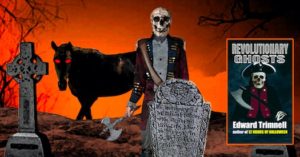Get the book (available in multiple formats!)
The main thrust of Harry Bailey’s article was that the Headless Horseman had returned—in 1976. That was the matter he covered next.
“And now, my friends, we come to the most disturbing aspect of this story. According to various eyewitness accounts, the Headless Horseman is indeed back, in this year of the American Bicentennial.
“The Headless Horseman has been seen in New York, New Jersey, and now in various locations in Pennsylvania.”
Harry Bailey then proceeded to give the readers of Spooky American Tales the details of some of these “eyewitness accounts”. They were all more or less the same. Someone driving alone in rural New England or Pennsylvania had seen the Headless Horseman galloping down some country road.
I noticed, however, that while eyewitnesses were quoted, no names were given. The cited source was always “a terrified witness in a small New Jersey town” or “a stunned believer not far from Philadelphia”.
Then Harry Bailey raised an issue that did get my attention.
“If only the Horseman were content to make these late-night appearances, to simply demonstrate his powers, and spread fear.
“There is evidence, however, that this horrible demon is once again claiming American victims, exactly as described in that classic short story of Washington Irving’s.
“This magazine has done some research. There has been a string of unexplained disappearances throughout western New England and Pennsylvania, along the trajectory of these eldritch nighttime sightings.
“All of the missing persons have been young, and all have disappeared from rural or semirural locations along the Horseman’s path.”
Harry Bailey enumerated a list of missing persons cases throughout New England and Pennsylvania. All of the missing were between the ages of sixteen and twenty-four, and all had disappeared since March.
Jennifer Willis, age 18, was last seen driving alone near Harrisburg, Pennsylvania. That was in April. Her parents had reported her missing, but no trace of her had been found.
Howard Thomas, age 22, left his job at a grocery store east of Pittsburgh on the night of March 23, 1976. He, too, was still missing.
I supposed that all of these missing persons cases were, in fact, real. But even at the age of seventeen, I recognized the difference between correlation and causation.
There were plenty of reasons why a young person might disappear. And decapitation by the Headless Horseman was by no means the most obvious one.
That said, for the first time I was forced to explicitly consider a connection between those hoofprints I had seen on the hillside adjacent to the Pantry Shelf, and the missing persons flyer that had been tacked onto the telephone pole.
There might be a connection.
But then again, there probably wasn’t.
Correlation and causation. They weren’t the same thing.
But Harry Bailey’s tale was about to become even more outlandish.

